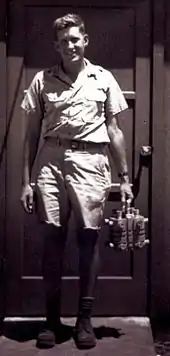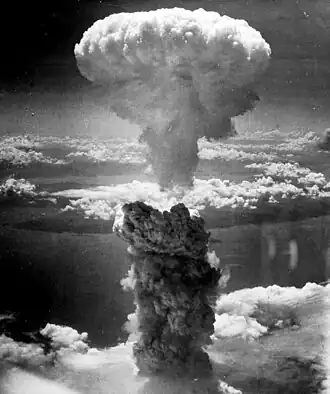Harold Agnew | |
|---|---|
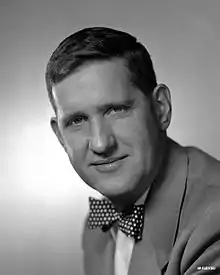 Agnew in 1955 | |
| Born | Harold Melvin Agnew March 28, 1921 Denver, Colorado, U.S. |
| Died | September 29, 2013 (aged 92) Solana Beach, California, U.S. |
| Education | University of Denver (BA) University of Chicago (MS, PhD) |
| Known for | Succeeded Norris Bradbury as director at Los Alamos |
| Awards | E. O. Lawrence Award (1966) Enrico Fermi Award (1978) |
| Scientific career | |
| Fields | Physics |
| Institutions | Los Alamos National Laboratory |
| Thesis | The Beta-spectra of Cesium-137, Yttrium-91, Chlorine-147, Ruthenium-106, Samarium-151, Phosphorus-32, and Thulium-170 (1949) |
| Doctoral advisor | Enrico Fermi |
Harold Melvin Agnew (March 28, 1921 – September 29, 2013) was an American physicist, best known for having flown as a scientific observer on the Hiroshima bombing mission and, later, as the third director of the Los Alamos National Laboratory.[1]
Agnew joined the Metallurgical Laboratory at the University of Chicago in 1942, and helped build Chicago Pile-1, the world's first nuclear reactor. In 1943, he joined the Los Alamos Laboratory, where he worked with the Cockcroft–Walton generator. After the war ended, he returned to the University of Chicago, where he completed his graduate work under Enrico Fermi.[2]
Agnew returned to Los Alamos in 1949, and worked on the Castle Bravo nuclear test at Bikini Atoll in 1954. He became head of the Weapon Nuclear Engineering Division in 1964. He also served as a Democratic New Mexico State Senator from 1955 to 1961, and was the Scientific Adviser to the NATO Supreme Allied Commander Europe (SACEUR) from 1961 to 1964. He was director of the Los Alamos National Laboratory from 1970 to 1979, when he resigned to become President and Chief Executive Officer of General Atomics. He died at his home in Solana Beach, California, on September 29, 2013.[3]
Early life and education
Harold Melvin Agnew was born in Denver, Colorado on March 28, 1921, the only child of a pair of stonecutters. He attended South Denver High School and entered the University of Denver, where he majored in chemistry. He was a strong athlete who pitched for the university softball team that won a championship. He left the University of Denver in January 1942, but had enough credits to graduate Phi Beta Kappa with his Bachelor of Arts degree in June, and he received a scholarship to Yale University.[4][5]
After the Japanese bombing of Pearl Harbor brought the United States into the Pacific War, Agnew and his girlfriend Beverly, a fellow graduate of South Denver High School and the University of Denver, attempted to join the United States Army Air Corps together. They were persuaded not to sign the enlistment papers. Instead, Joyce C. Stearns, the head of the physics department at the University of Denver, persuaded Agnew to come with him to the University of Chicago, where Stearns became the deputy head of the Metallurgical Laboratory. Although Agnew had enough credits to graduate, Beverly did not and had to remain behind. They were married in Denver on May 2, 1942. They then went to Chicago, where Beverly became a secretary to Richard L. Doan, then head of the Metallurgical Laboratory. Agnew and Beverly had two children, a daughter Nancy, and a son, John.[4][6]
At the Metallurgical Laboratory, Agnew worked with Enrico Fermi, Walter Zinn and Herbert L. Anderson.[4] There, he was involved in the construction of Chicago Pile-1. Initially, Agnew worked with the instrumentation. The Geiger counters were calibrated using a radon-beryllium source, and Agnew received too high a dose of radiation. He was then put to work stacking the graphite bricks that were the reactor's neutron moderator. He witnessed the first controlled nuclear chain reaction when the reactor went critical on December 2, 1942.[7][5][8]
Agnew and Beverly moved to the Los Alamos Laboratory in March 1943.[5] Agnew, Beverly and Bernard Waldman first went to the University of Illinois, where the men disassembled the Cockcroft–Walton generator and particle accelerator while Beverly catalogued all the parts. The parts were shipped to New Mexico, where Agnew and Beverly met up with them, and rode the trucks hauling them to the Los Alamos Laboratory. There, Beverly worked as a secretary, initially with Robert Oppenheimer and his secretary Priscilla Green. She then became secretary to Robert Bacher, the head of Physics (P) Division, and later the Gadget (G) Division, for the rest of the war. Agnew's job was to reassemble the accelerator, which was then used for experiments by John Manley's group.[6][9]
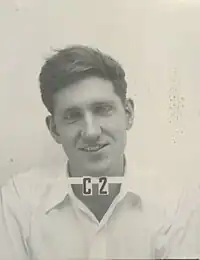 Harold M. Agnew |
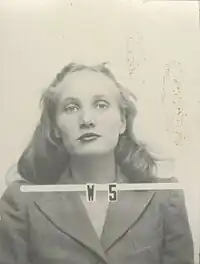 Beverly J. Agnew |
When experimental work wound down, Agnew was transferred to Project Alberta, working as part of Luis W. Alvarez's group, whose role was to monitor the yield of nuclear explosions. With Alvarez and Lawrence H. Johnston, Agnew had devised a method for measuring the yield of the nuclear blast by dropping pressure gauges on parachutes and telemetering the readings back to the plane.[10] In June 1945, he was issued an Army uniform and dog tags at Wendover Army Air Field, Utah, and was flown to Tinian in the Western Pacific in a C-54 of the 509th Composite Group. Agnew's first task was to install his yield measurement instrumentation in the Boeing B-29 Superfortress aircraft The Great Artiste.[11]
During the atomic bombing of Hiroshima, on August 6, 1945, Agnew, along with Alvarez and Johnston, flew as a scientific observer in The Great Artiste, piloted by Charles Sweeney, which tailed the Enola Gay as the instrumentation aircraft. Agnew later recalled, "After we dropped our gauges I remember we made a sharp turn to the right so that we would not get caught in the blast – but we still got badly shaken up by it." He brought along a movie camera and took the only existing movies of the Hiroshima event as seen from the air.[10][12][13]
After the war ended, Agnew entered the University of Chicago, where he completed his graduate work under Fermi. Agnew and Beverly stayed with Fermi and his family, due to the post-war housing shortage.[9] He received his Master of Science (MS) degree in 1948 and his Doctor of Philosophy (PhD) degree in 1949,[14] writing his thesis on "The beta-spectra of Cs137, Y91, Pm147, Ru106, Sm151, P32, Tm170".[15] Fellow postgraduate students at Chicago at the time included Tsung-Dao Lee, Chen Ning Yang, Owen Chamberlain and Jack Steinberger.[14]
Los Alamos years

With his doctorate in hand, Agnew returned to Los Alamos as a National Research Foundation Fellow, and worked on weapons development in the Physics Division.[13] In 1950, he was assigned to the thermonuclear weapons project, and was project engineer for the Castle Bravo nuclear test at Bikini Atoll in 1954.[16][17] He became head of the Weapon Nuclear Engineering Division in 1964.[13]
Agnew served as a Democratic New Mexico State Senator from 1955 to 1961.[18] He was the first state senator to be elected from Los Alamos County. Senators served unpaid, receiving only a per diem allowance of five dollars.[19] Since the New Mexico legislature convened for only 30 days in even numbered years and 60 days in odd numbered years,[20] he was able to continue working at Los Alamos, taking leave without pay to attend.[19] He attempted to reform New Mexico's liquor laws, which specified a minimum mark-up. He was unsuccessful in 1957, but the law was reformed in 1963.[21]
From 1961 to 1964, he was Scientific Adviser to the NATO Supreme Allied Commander Europe (SACEUR). He also held a number of part-time advisory position with the military over the years. He was a member of the United States Air Force Scientific Advisory Board from 1957 to 1968, and was chairman of the Science Advisory Group of the United States Army's Combat Development Command from 1966 to 1970. He was a member of the Defense Science Board from 1966 to 1970, the Army's Scientific Advisory Panel from 1966 to 1974, and the Army Science Board from 1978 to 1984.[13]
Agnew became director of the Los Alamos National Laboratory in 1970, when it had 7,000 employees.[22] He took over at a time of great change. His predecessor, Norris Bradbury, had rebuilt the laboratory from scratch after the war, and many of the people he had brought in were approaching retirement.[23] Under his directorship, Los Alamos developed an underground test containment program, completed its Meson Physics Facility, acquired the first Cray supercomputer, and trained the first class of International Atomic Energy Agency inspectors.[24] Agnew managed to get the Los Alamos Laboratory responsibility for the development of the W76, used by the Trident I and Trident II Submarine Launched Ballistic Missiles, and the W78 used by the Minuteman III intercontinental ballistic missiles. He was proud of the work with insensitive high explosive that made nuclear weapons safer to handle. Support from the Atomic Energy Commission for reactor development dried up, but during the 1970s energy crisis, the laboratory explored other types of alternative fuels.[23]
Later life
In 1979, Agnew resigned from Los Alamos and became President and Chief Executive Officer of General Atomics, a position he held until 1985.[13] In his letter of resignation to David S. Saxon, the President of the University of California, Agnew wrote that his decision was influenced by "dissatisfaction with University administration policies and a lack of advocacy for the total LASL [Los Alamos Scientific Laboratory] program" and "frustration with what I consider to be a continuing inequitable distribution of defense program funding by the Department of Energy between the LASL and LLL [Lawrence Livermore Laboratory]."[25]
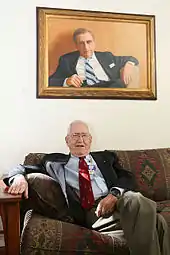
Agnew chaired the General Advisory Committee of the Arms Control and Disarmament Agency from 1974 to 1978, and served as a White House science councillor from 1982 to 1989. He was a member of NASA's Aerospace Safety Advisory Panel from 1968 to 1974, and from 1978 to 1987. He became an adjunct professor at the University of California, San Diego in 1988. He was the recipient of the E.O. Lawrence Award in 1966, and of the Department of Energy's Enrico Fermi Award in 1978. Along with Hans Bethe, Agnew was the first to receive the Los Alamos National Laboratory Medal. He was a member of the National Academy of Sciences and the National Academy of Engineering.[8][13][26][27]
A proponent of tactical nuclear weapons, Agnew pointed out in 1970 that the Thanh Hoa Bridge in Vietnam required hundreds of sorties to destroy with conventional weapons when a nuclear weapon could have done the job with just one.[28] In a 1977 article for the Bulletin of the Atomic Scientists, Agnew argued that the fusion reactions of neutron bombs could provide "tactical" advantages over conventional fission weapons, especially in countering the "massive armor component possessed by the Eastern bloc." Citing conclusions reached by the Rand Corporation, Agnew argued that without affecting the armor of a tank, the neutrons produced by a fusion blast would penetrate the vehicle and "in a matter of a few tens of minutes to hours kill or make the crew completely ineffective." Because the neutron bomb reduced collateral damage, it could be used in a much more selective fashion than a fission weapon, thereby providing a clear "advantage for the military defender as well as for the nearby non-combatant."[29]
Agnew maintained that no new U.S. nuclear weapon design could be certified without nuclear testing, and that stockpile reliability stewardship without such testing may be problematic.[30] In a 1999 letter to the Wall Street Journal, he commented on the significance of allegations of Chinese nuclear espionage. "As long as any nation has a demonstrated nuclear capability and a means of delivering its bombs and warheads, it doesn't really matter whether the warheads are a little smaller or painted a color other than red, white, and blue," he wrote. "I suspect information published in the open by the National [sic.] Resources Defense Council has been as useful to other nations as any computer codes they may have received by illegal means."[31]
Beverly died on October 11, 2011.[6] Agnew was diagnosed with chronic lymphocytic leukemia, and died at his home in Solana Beach, California, on September 29, 2013, while watching football on television.[18][22] He was survived by his daughter Nancy and son John.[5] He had arranged to be cremated and to have his ashes interred with Beverly at the Guaje Pines Cemetery in Los Alamos.[32]
In a 2005 BBC interview, Agnew stated, "About three-quarters of the U.S. nuclear arsenal was designed under my tutelage at Los Alamos. That is my legacy."[12]
Notes
- ↑ "Harold Agnew". Atomic Heritage Foundation. Retrieved November 28, 2022.
- ↑ "Harold Agnew with the Plutonium Core | Photographs | Media Gallery". www.atomicarchive.com. Retrieved November 28, 2022.
- ↑ Press, William H. (November 26, 2013). "Harold Agnew, physicist, atomic bomb Everyman". Proceedings of the National Academy of Sciences. 110 (48): 19179–19180. Bibcode:2013PNAS..11019179P. doi:10.1073/pnas.1319623110. ISSN 0027-8424. PMC 3845108. PMID 24248340.
- 1 2 3 Palevsky 2005, pp. 2–3.
- 1 2 3 4 Broad, William J. (October 1, 2013). "Harold M. Agnew, Physicist Present at Birth of the Nuclear Age, Dies at 92". New York Times. Retrieved October 6, 2013.
- 1 2 3 "In Memoriam: Agnew and Ramsey" (PDF). Los Alamos Historical Society Newsletter. 30 (4): 3. December 2011. Archived from the original (PDF) on March 4, 2016. Retrieved December 30, 2015.
- ↑ Palevsky 2005, p. 5.
- 1 2 "Harold Agnew". Nuclear Age Peace Foundation. Retrieved December 21, 2011.
- 1 2 "Harold Agnew's Interview". Manhattan Project Voices. Retrieved October 6, 2013.
- 1 2 "American Experience . Race for the Superbomb . Harold Agnew on: The Hiroshima Mission". PBS. Archived from the original on October 12, 2013. Retrieved December 21, 2011.
- ↑ Krauss & Krauss 2005, p. 343.
- 1 2 "The men who bombed Hiroshima". BBC. Retrieved December 21, 2011.
- 1 2 3 4 5 6 "Harold Agnew". American Institute of Physics. Archived from the original on August 30, 2010. Retrieved December 21, 2011.
- 1 2 Palevsky 2005, p. 10.
- ↑ "The beta spectra of Cs137, Y91, Chlorine147, Ru106, Sm151, P32, Tm170". University of Chicago. Archived from the original on October 12, 2013. Retrieved October 6, 2013.
- ↑ "Operation Castle". Nuclear Weapon Archive. Retrieved October 6, 2013.
- ↑ Palevsky 2005, p. 16.
- 1 2 Sharpe, Tom (September 30, 2013). "Former Los Alamos lab director Harold Agnew dies at 92". The Santa Fe New Mexican. Retrieved October 6, 2013.
- 1 2 "Interview with Harold M. Agnew". Nevada Test Site Oral History Project. Solana Beach, California: University of Nevada, Las Vegas. October 10, 2005. Archived from the original on November 1, 2013. Retrieved October 29, 2013.
- ↑ "New Mexico State Legislature" (PDF). New Mexico Legislature. Archived from the original (PDF) on October 31, 2013. Retrieved October 20, 2013.
- ↑ Roybal 2008, pp. 186–189.
- 1 2 Woo, Elaine (October 3, 2013). "Harold Agnew, head of atomic laboratory, dies at 92". The Washington Post. Retrieved October 6, 2013.
- 1 2 "The Times They Were a Changin'" (PDF). Los Alamos Science. 4 (7): 73–79. Winter–Spring 1983. Archived from the original (PDF) on October 12, 2013. Retrieved October 6, 2013.
- ↑ "The Agnew Years (1970–1979)". Los Alamos National Laboratory. Retrieved December 21, 2011.
- ↑ "Agnew quits Los Alamos, goes to General Atomic". Physics Today. 32 (5): 116. May 1979. doi:10.1063/1.2995534.
- ↑ "Award Laureates". Department of Energy. Retrieved December 21, 2011.
- ↑ "Members". National Academy of Engineering. Retrieved April 10, 2013.
- ↑ "Vintage Agnew" (PDF). Los Alamos Science. 4 (7): 69–72. Winter–Spring 1983. Archived from the original (PDF) on October 12, 2013. Retrieved October 6, 2013.
- ↑ "Profile of Harold Agnew". Institute for Policy Studies. Retrieved December 21, 2011.
- ↑ DeWitt, Hugh E.; Marsh, Gerald E. (April 1984). "Stockpile reliability and nuclear testing". Bulletin of the Atomic Scientists. 1 (8): 40–41. doi:10.1080/00963402.1984.11459283. Retrieved December 21, 2011.
- ↑ "Letter to the Editor: "Looking for Spies in Nuclear Kitchen"". Wall Street Journal. May 17, 1999. p. A27.
- ↑ "Harold Agnew (1921–2013)". Nuclear Diner. Archived from the original on October 12, 2013. Retrieved October 6, 2013.
References
- Krauss, Robert; Krauss, Amelia, eds. (2005). The 509th Remembered: A History of the 509th Composite Group as Told by the Veterans Themselves, 509th Anniversary Reunion, Wichita, Kansas October 7–10, 2004. Buchanan, Michigan: 509th Press. ISBN 978-0-923568-66-5. OCLC 59148135.
- Palevsky, Mary (October 10, 2005). Interview with Harold M. Agnew. University of Nevada, Las Vegas Libraries. Archived from the original on June 23, 2017. Retrieved December 27, 2011.
- Roybal, David (2008). Taking on Giants : Fabián Chávez, Jr. and New Mexico Politics. Albuquerque: University of New Mexico Press. ISBN 978-0-826344-36-6.
External links
- 1994 Audio Interview with Harold Agnew by Richard Rhodes Voices of the Manhattan Project
- 1992 Video Interview with Harold Agnew by Theresa Strottman Voices of the Manhattan Project
- Register of the Harold Melvin Agnew motion picture film at the Hoover Institution Archives, Stanford University
- Oral History interview transcript for Harold M. Agnew 22 May 2006, American Institute of Physics, Niels Bohr Library and Archives
- Oral History interview transcript for Harold M. Agnew 15 February 2007, American Institute of Physics, Niels Bohr Library and Archives
- Richard L. Garwin, "Harold M. Agnew", Biographical Memoirs of the National Academy of Sciences (2015)
